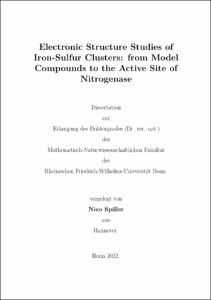Electronic Structure Studies of Iron-Sulfur Clusters: from Model Compounds to the Active Site of Nitrogenase

Electronic Structure Studies of Iron-Sulfur Clusters: from Model Compounds to the Active Site of Nitrogenase

| dc.contributor.advisor | Neese, Frank | |
| dc.contributor.author | Spiller, Nico | |
| dc.date.accessioned | 2022-08-23T16:50:37Z | |
| dc.date.available | 2022-08-23T16:50:37Z | |
| dc.date.issued | 23.08.2022 | |
| dc.identifier.uri | https://hdl.handle.net/20.500.11811/10176 | |
| dc.description.abstract | Iron-sulfur (FeS) clusters are omnipresent in nature, where they are involved in a variety of tasks, such as electron transfer, DNA repair, Fe storage, and substrate activation. The enzyme nitrogenase contains one of the largest known biological FeS clusters. Nitrogenase is responsible for the conversion of inert N2 gas to bioavailable ammonia, a reaction that is copied by the industrial Haber-Bosch process. However, despite decades of research, little is known about the molecular mechanism behind enzymatic N The study is divided into four parts, each focusing on different characteristics of FeS clusters: (i) S and Se are compared as bridging ligands in [Fe2X2]2+,1+ (X = S,Se) synthetic model compounds. The electronic structure is calculated with the complete active space self-consistent field method (CASSCF). S→Se substitution is shown to reduce the antiferromagnetic coupling strength between the Fe centers, which can be related to a decrease in Heisenberg exchange and vibronic coupling and an increase in double exchange. Se-bridged Fe centers are relevant to nitrogenase, because selective replacement of S with Se is used to probe the electronic structure in FeMoco with element-specific techniques. (ii) Cysteine (Cys) and serine (Ser) are compared as terminal ligands for the [Fe2X2]1+ ferredoxins from Clostridium pasteurianum (Cp) and Aquifex aeolicus (Aae). According to density functional theory (DFT) cluster models, the valence-localized electronic structure (Fe2+Fe3+) is stabilized with only Cys terminal ligands, while Cys→Ser replacement stabilizes a valence-delocalized electronic structure (Fe2.5+Fe2.5+). Cys→Ser variants of the ferredoxins from Cp and Aae are the only known examples for valence-delocalized [Fe2X2]1+ clusters, but valence-delocalization is frequently encountered in higher-nuclearity FeS clusters, such as FeMoco. (iii) The electronic structure of FeMoco in the E0 resting state of the MoFo protein is analyzed in detail and compared to the FeVco, the active site in the alternative V nitrogenase. The proteins are modeled with a cluster model and a quantum mechanics/molecular mechanics (QM/MM) model, where DFT in is used for the QM part. It is shown that the energy of a given spin-coupling pattern is related to the antiferromagnetic coupling strength between Fe pairs. It is further shown that the MoFe and the VFe protein are responsible for distinct charge distributions in the respective active sites, which may be related to their distinct reactivities. (iv) Binding of the inhibitor carbon monoxide (CO) to the active site of nitrogenase is explored with a QM/MM model. The results of the E1 redox state model of the MoFe protein are consistent with experimental CO vibrational frequencies. No large differences were observed between the Mo and the V nitrogenase models, even though V nitrogenase has been reported to bind CO without enzymatic reduction. | en |
| dc.language.iso | eng | |
| dc.rights | Namensnennung 4.0 International | |
| dc.rights.uri | http://creativecommons.org/licenses/by/4.0/ | |
| dc.subject | nitrogenase | |
| dc.subject | iron-sulfur clusters | |
| dc.subject | qm/mm | |
| dc.subject | casscf | |
| dc.subject | computational chemistry | |
| dc.subject | proteins | |
| dc.subject | magnetism | |
| dc.subject.ddc | 540 Chemie | |
| dc.title | Electronic Structure Studies of Iron-Sulfur Clusters: from Model Compounds to the Active Site of Nitrogenase | |
| dc.type | Dissertation oder Habilitation | |
| dc.publisher.name | Universitäts- und Landesbibliothek Bonn | |
| dc.publisher.location | Bonn | |
| dc.rights.accessRights | openAccess | |
| dc.identifier.urn | https://nbn-resolving.org/urn:nbn:de:hbz:5-67466 | |
| dc.relation.doi | https://doi.org/10.1021/acs.inorgchem.1c02649 | |
| dc.relation.doi | https://doi.org/10.1002/ejic.202000033 | |
| ulbbn.pubtype | Erstveröffentlichung | |
| ulbbnediss.affiliation.name | Rheinische Friedrich-Wilhelms-Universität Bonn | |
| ulbbnediss.affiliation.location | Bonn | |
| ulbbnediss.thesis.level | Dissertation | |
| ulbbnediss.dissID | 6746 | |
| ulbbnediss.date.accepted | 13.06.2022 | |
| ulbbnediss.institute | Mathematisch-Naturwissenschaftliche Fakultät : Fachgruppe Chemie / Institut für Physikalische und Theoretische Chemie | |
| ulbbnediss.fakultaet | Mathematisch-Naturwissenschaftliche Fakultät | |
| dc.contributor.coReferee | Grimme, Stefan | |
| dcterms.hasSupplement | https://github.com/nspiller/phd_notebook | |
| ulbbnediss.contributor.orcid | https://orcid.org/0000-0002-6293-4867 | |
| ulbbnediss.contributor.gnd | 1269928597 |
Files in this item
This item appears in the following Collection(s)
-
E-Dissertationen (4458)




